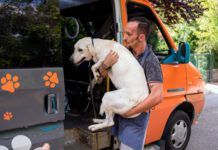In 2010, I noticed a surge in news articles concerning law enforcement officers who had shot a dog. Most recently, I read about an October 1 incident in Oakland, California, in which an officer responding to a home burglar alarm shot and killed the resident 11-year-old arthritic yellow Labrador Retriever. Another alarming article described the fatal shooting of Parrot, a pit bull-mix who had bitten another dog at a Washington, D.C., street festival but was already controlled by his foster parent when police grabbed and shot the dog. In another article, I read about two Labrador Retrievers who were killed in their own home – which also happened to be the home of the mayor of a small town in Maryland – when police served a search warrant on the wrong address.
Via YouTube.com, I learned of a case in which a police officer in LaGrange, Missouri, shot a dog who was clearly not a threat to anyone’s safety at that time. The video was shot from the police car – and then somehow widely circulated on YouTube. Two officers are present, but after one proves unable to maneuver the dog (who is secured by a control pole) into a truck by himself, he shoots the dog.
Horrified by this rash of cases, I started looking into how many dogs are killed by police. It appears that an average of 250-300 cases of officers shooting dogs are reported in the media every year. Randall Lockwood, PhD, ASPCA Senior Vice President for Forensic Sciences and Anti-Cruelty Projects, has also looked into this matter, and suggests that as many as another 1,000 cases may go unreported, for a staggering average of more than three dog shootings per day in the United States.
This issue is of concern to every citizen. Regard for canine life aside, every time an officer fires his weapon he also puts human lives at risk – as evidenced by a September shooting in which a Detroit police officer who shot at a pit bull actually hit and wounded an animal control officer who was present during a raid on a home. There are simply safer and more humane methods to deal with most of the dogs that police officers must handle during the course of their difficult jobs. Officers should have the opportunity to receive training in how to assess the potential for danger from dogs, and how to use their non-lethal equipment to handle potentially dangerous dogs.
I’ve created a yet-unnamed online group whose purpose is constructive discussion and strategy development to combat the apparently growing incidence of law enforcement officers shooting dogs without adequate justification. Join by sending a message to copsshootingdogs-subscribe@yahoogroups.com. This is not a site to bash law enforcement, but rather to engage in constructive discussions to find and promote positive solutions to this problem. – Pat Miller





